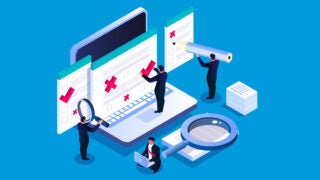iPhone’s 10th birthday: Pros and cons of screen time addiction
Apple released its first iPhone on June 29, 2007 — forever changing how people interact with each other and the world. A decade later, smartphones are seemingly welded into hands, leaving people feeling vulnerable when they forget the device at home. USC researchers discuss the pros and cons of how smartphones have transformed our daily lives.
Contact: Zen Vuong at (213) 300-1381 or zvuong@usc.edu
 This is your brain on internet use
This is your brain on internet use
“Internet addiction has some behavioral similarities to hard drug use. There is a relationship between how addicted someone is to social media and how strong or how different the brain signals are in specific regions. The similarities between internet addiction and cocaine addiction really lie in those brain systems that drive you toward the reward, including release of the reward and pleasure neurotransmitter dopamine.
“However, there are fundamental differences, too. Cocaine use usually involves impairments in the prefrontal cortex, which leads to poor decision-making across many facets of life. But internet addiction usually does not involve prefrontal cortex impairments.”
Antoine Bechara can discuss the neuroscience of decision-making, addiction, substance abuse and gambling. He is a psychology professor and neuroscientist at the USC Dornsife College of Letters, Arts and Sciences. He explains in this video how the use of social media triggers the brain’s rewards system.
Contact: (213) 821-2487 or bechara@usc.edu
Swiping right on Tinder activates the ‘pleasure center’ in your brain
“Swiping on apps is inherently rewarding due to a dopamine hit in the brain every time a new message is received. The affected area is the same ‘pleasure center’ activated by cocaine and other addictive drugs.
“The addictive qualities of swiping on dating apps like Tinder has important implications for relationships: These dating apps serve as an omnipresent ‘other’ that potentially undermines relationships by providing a seemingly limitless array of attractive others for romantic or sexual dalliances. As such, it can serve to undermine one’s willingness to commit to or sustain a monogamous relationship due to the ever-present element of choice.”
Julie Albright is a digital sociologist who works at the intersection of behavior and technology. She is writing a book on the impact of smartphones on relationships and society. One chapter discusses how the internet is the “other” in personal relationships.
Albright lectures on psychology at the USC Dornsife College of Letters, Arts and Sciences.
Contact: (213) 740‑1076 or albright@usc.edu
Too much smartphone use dampens productivity, especially among younger people
“Smartphones are addictive due to their ultra-portability. The prevalence of smartphone addiction is predominant among youth and young adults, though it may be increasing among older adults as well.
“Consequences associated with smartphone addiction include lack of concentration and decreased performance at school or work, car and other accidents, possible blurred vision, sleep disturbance, and financial costs. Research is only beginning in this arena. Our ongoing review study could help develop evidence-based guidelines on treating smartphone addiction.”
Steve Sussman can discuss substance and behavioral addictions as well as prevention and cessation programs that enable people to lead healthier lives. He authored “Substance and Behavioral Addictions: Concepts, Causes and Cures,” which focuses on addiction to substances (tobacco, alcohol, drugs, food) and behavior (electronic media, gambling, shopping, work). Sussman is a professor of preventive medicine, psychology and social work at the Keck School of Medicine of USC.
Contact: (323) 442-8220 or ssussma@usc.edu
Data collected from mobile phones can improve health
“Some people say kids and teens overuse their smartphones, but with an object that is so new, it’s difficult to set a limit to proper use. Moreover, it’s not easy to control screen time because children and adolescents use screens, including smartphones, to access information for homework. Of course, they also use smartphones to access games and social media, which definitely has had some harmful effects, including an influx of cyberbullying.
“Yet mobile phones can be harnessed for good in real time and in appropriate situations. Our research uses smartphone-derived data to develop interventions — tips, push alerts and information — that can help children and families.”
Donna Spruijt-Metz can discuss childhood obesity and mobile health technologies that help to increase physical activity in overweight minority youth. She is director of the USC mHealth (Mobile Health) Collaboratory at USC’s Center for Economic and Social Research at the USC Dornsife College of Letters, Arts and Sciences and is a research professor in the Department of Preventive Medicine at the Keck School of Medicine of USC.
Contact: (213) 821‑1775 or dmetz@usc.edu
Social media: The public pulse
“All of the time people spend on their smartphones and posting on social media results in ‘big social media data.’ By listening to what people are saying in organic ways, we have the ability to understand public sentiment, attitudes and behaviors.
“Our studies underscore the value of big social media data in providing rapid and reliable information that can make public health and policy experts more responsive to the people they serve.”
Jon-Patrick Allem can discuss big data, social media and health communication. His research gleans insight from posts on Twitter, Instagram, YouTube and Facebook as well as from terms used in a Google search. Allem is a research scientist in the Department of Preventive Medicine at the Keck School of Medicine of USC.
Contact: (858) 603-0812 or allem@usc.edu







